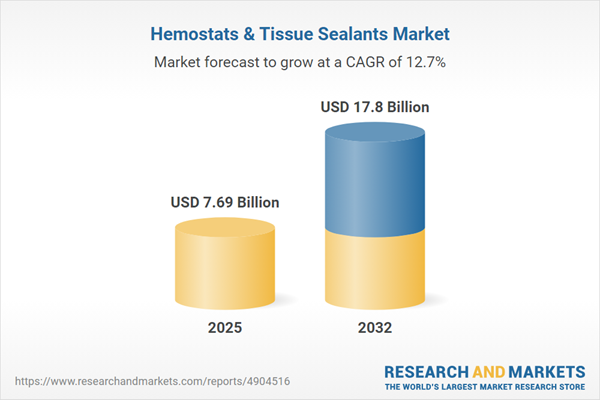Speak directly to the analyst to clarify any post sales queries you may have.
The global hemostats and tissue sealants market is evolving rapidly, shaped by medical innovation, clinical need, and regulatory dynamics. Senior leaders must navigate increasing product specialization, complex supply chains, and shifting standards to remain competitive in this vital healthcare sector.
Market Snapshot: Hemostats & Tissue Sealants Market Overview
The Hemostats & Tissue Sealants Market grew from USD 6.85 billion in 2024 to USD 7.69 billion in 2025. Forecasts indicate continued expansion at a CAGR of 12.67%, with the market projected to reach USD 17.80 billion by 2032. This surge reflects rising clinical demand, greater adoption in minimally invasive procedures, and impactful shifts in healthcare reimbursement and procurement practices.
Scope & Segmentation
- Product Types: Hemostats include active hemostats, flowable hemostats, and mechanical hemostats. Tissue sealants encompass fibrin sealants and synthetic sealants.
- Material Types: Natural materials—bovine-derived and human-derived—and synthetic materials such as collagen-based and polymer-based alternatives.
- Applications: Non-surgical procedures (diagnostic and minor wound sealing) and surgical procedures (cardiovascular, gastrointestinal, and general surgery).
- End Users: Ambulatory surgical centers, clinics, and hospitals, reflecting a broad spectrum of clinical environments.
- Regions: Americas (United States, Canada, Mexico, Brazil, Argentina, Chile, Colombia, Peru), Europe, Middle East & Africa (United Kingdom, Germany, France, Russia, Italy, Spain, Netherlands, Sweden, Poland, Switzerland, United Arab Emirates, Saudi Arabia, Qatar, Turkey, Israel, South Africa, Nigeria, Egypt, Kenya), and Asia-Pacific (China, India, Japan, Australia, South Korea, Indonesia, Thailand, Malaysia, Singapore, Taiwan).
- Companies Covered: Includes major manufacturers and innovators such as Abbott Laboratories, Johnson & Johnson Services, Inc., Medtronic PLC, Smith & Nephew PLC, Stryker Corporation, Baxter International Inc., and many more.
Key Takeaways for Senior Decision-Makers
- Market growth is driven by advanced biomaterials, specialized clinical applications, and increasing emphasis on procedural efficiency.
- Technological innovation is shifting focus toward synthetic polymers and bioactive materials, which aim to reduce immunogenic risks and improve usability in diverse surgical contexts.
- Heightened regulatory scrutiny is resulting in robust validation protocols, compelling manufacturers to invest in real-world evidence and extensive clinical trials to demonstrate product performance.
- Supply chain strategy is critical, especially in managing the impact of global sourcing, trade policy volatility, and localization demands.
- Adoption of enhanced recovery protocols highlights the need for products that minimize bleeding and facilitate quicker patient turnover across care settings.
- Collaboration among manufacturers, clinicians, and materials scientists is fostering the co-development of next-generation solutions tailored to emerging clinical standards.
Tariff Impact on Supply Chains and Pricing Structures
Recent United States tariffs have substantially influenced the hemostats and tissue sealants supply chain. Manufacturers dependent on imported raw materials—such as advanced polymers and plasma derivatives—face elevated duties, adjusting sourcing models and exploring domestic or alternative partnerships to offset cost pressures and regulatory impacts. In response, healthcare providers and distributors are reassessing procurement strategies, often seeking volume agreements and considering options that are less sensitive to international trade fluctuations. This environment has intensified interest in supply chain diversification and localization.
Methodology & Data Sources
The report is based on primary interviews with key opinion leaders in surgery, procurement, and regulatory affairs, supplemented by comprehensive secondary research from journals, government publications, and patent databases. Quantitative and qualitative insights are validated through triangulation and expert review, ensuring credible, actionable intelligence.
Why This Report Matters
- Offers focused strategic recommendations tailored for senior stakeholders navigating regulatory changes, shifting market dynamics, and opportunities in advanced product portfolios.
- Enables deeper understanding of segmentation and regional trends, supporting informed decisions in product development, market entry, and supply chain management.
- Provides a detailed view on the impacts of trade policies and regulatory frameworks, helping organizations align business strategies with market realities.
Conclusion
The hemostats and tissue sealants market demands ongoing agility from decision-makers, given its dynamic technological and regulatory context. This report equips leaders to refine strategies, optimize resources, and effectively capture growth amid evolving clinical needs.
Additional Product Information:
- Purchase of this report includes 1 year online access with quarterly updates.
- This report can be updated on request. Please contact our Customer Experience team using the Ask a Question widget on our website.
Table of Contents
3. Executive Summary
4. Market Overview
7. Cumulative Impact of Artificial Intelligence 2025
Companies Mentioned
The companies profiled in this Hemostats & Tissue Sealants market report include:- Abbott Laboratories
- Advanced Medical Solutions Group PLC
- Aegis Lifesciences Private Limited.
- B. Braun SE
- Baxter International Inc.
- Becton, Dickinson and Company
- Cardinal Health, Inc.
- CooperSurgical, Inc.
- CryoLife, Inc.
- CSL Behring
- CuraMedical B.V.
- Grifols, S.A.
- Hemostasis, LLC
- Hologic, Inc.
- Integra LifeSciences Corporation
- Johnson & Johnson Services, Inc.
- KAKEN PHARMACEUTICAL CO., LTD.
- KATSAN Katgüt Sanayi ve Tic. A.Ş.
- Medline Industries, LP.
- Medtronic PLC
- Olympus Corporation
- Owens & Minor
- Pfizer, Inc.
- Smith & Nephew PLC
- Stryker Corporation
- Teleflex Incorporated
- Terumo Corporation
- Thermo Fisher Scientific Inc.
- Vivostat A/S
- Zimmer Biomet
Table Information
| Report Attribute | Details |
|---|---|
| No. of Pages | 183 |
| Published | November 2025 |
| Forecast Period | 2025 - 2032 |
| Estimated Market Value ( USD | $ 7.69 Billion |
| Forecasted Market Value ( USD | $ 17.8 Billion |
| Compound Annual Growth Rate | 12.6% |
| Regions Covered | Global |
| No. of Companies Mentioned | 31 |









